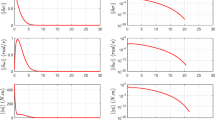Abstract
An efficient and accurate computational approach is proposed for a nonconvex optimal attitude control for a rigid body. The problem is formulated directly as a discrete time optimization problem using a Lie group variational integrator. Discrete time necessary conditions for optimality are derived, and an efficient computational approach is proposed to solve the resulting two-point boundary-value problem. This formulation wherein the optimal control problem is solved based on discretization of the attitude dynamics and derivation of discrete time necessary conditions, rather than development and discretization of continuous time necessary conditions, is shown to have significant advantages. In particular, the use of geometrically exact computations on SO(3) guarantees that this optimal control approach has excellent convergence properties even for highly nonlinear large angle attitude maneuvers.
Similar content being viewed by others
References
J. T. Betts, Practical methods for optimal control using nonlinear programming. SIAM (2001).
A. E. Bryson and Yu-Chi Ho, Applied optimal control. Hemisphere Publishing Corporation (1975).
E. Hairer, C. Lubich, and G. Wanner, Geometric numerical integration illustrated by the Störmer–Verlet method. Acta Numer. 12 (2003), 399–450.
I. I. Hussein and A. M. Bloch, Optimal control on Riemannian manifolds with potential fields. In: Proc. IEEE Conf. on Decision and Control (2004), 1982–1987.
I. I. Hussein, M. Leok, A. K. Sanyal, and A. M. Bloch, A discrete variational integrator for optimal control problems on SO(3). Proc. IEEE Conf. on Decision and Control (2006), 6636–6641.
A. Iserles, H. Z. Munthe-Kaas, S. P. Nørsett, and A. Zanna, Lie-group methods. Acta Numer. 9 (2000), 215–365.
O. Junge, J. E. Marsden, and S. Ober-Blöbaum, Discrete mechanics and optimal control. IFAC Congr., Praha (2005).
V. Jurdjevic, Geometric control theory. Cambridge Univ. Press (1997).
C. T. Kelley, Iterative methods for linear and nonlinear equations. SIAM (1995).
T. Lee, M. Leok, and N. H. McClamroch, A Lie group variational integrator for the attitude dynamics of a rigid body with applications to the 3D pendulum. Proc. IEEE Conf. on Control Applications (2005), 962–967.
_____, Attitude maneuvers of a rigid spacecraft in a circular orbit. Proc. Amer. Control Conf. (2005), 1742–1747.
_____, Optimal attitude control for a rigid body with symmetry. Proc. Amer. Control Conf. (2007), 1073–1078. http://arxiv.org/abs/math.OC/06009482.
_____, A combinatorial optimal control problem for spacecraft formation reconfiguration. Proc. IEEE Conf. on Decision and Control (2007). http://arxiv.org/abs/math.OC/0702738.
_____, Optimal control of a rigid body using geometrically exact computations on SE(3). Proc. IEEE Conf. on Decision and Control (2006), 2170–2175. http://arxiv.org/abs/math.OC/0602588.
_____, Lie group variational integrators for the full body problem. Comput. Methods Appl. Mech. Engineering 196 (2007), 2907–2924.
_____, Lie group variational integrators for the full body problem in orbital mechanics. Celest. Mech. Dynam. Astronomy 98 (2007), No. 2, 121–144.
_____, Time optimal attitude control for a rigid body. Proc. Amer. Control Conf. (2008).
M. Leok, Generalized Galerkin variational integrators. Preprint (2004), http://arxiv.org/math.NA/0508360.
_____, Foundations of computational geometric mechanics. California Inst. of Technology (2004).
T. R. Littell, R. D. Skeel, and M. Zhang, Error analysis of symplectic multiple time stepping. SIAM J. Numer. Anal. 34 (1997), No. 5, 1792–1807.
J. E. Marsden and M. West, Discrete mechanics and variational integrators. Acta Numer. 10 (2001), 357–514.
J. Shen, A. K. Sanyal, N. A. Chaturvedi, D. Bernstein, and N. H. Mc-Clamroch, Dynamics and control of a 3D pendulum. Proc. 43rd IEEE Conf. on Decision and Control (2004), 323–328.
K. Spindler, Optimal control on Lie groups with applications to attitude control. Math. Control Signals Systems 11 (1998), 197–219.
M. Suzuki, Improved Trotter-like formula. Phys. Lett. A 180 (1993), No. 3, 232–234.
B. Wie, Space vehicle dynamics and control. AIAA (1998).
Author information
Authors and Affiliations
Corresponding author
Additional information
The first and second authors have been partially supported by NSF (project Nos. DMS-0504747 and DMS-0726263). The first and third authors have been partially supported by NSF (project Nos. ECS-0244977 and CMS-0555797.
Rights and permissions
About this article
Cite this article
Lee, T., Leok, M. & McClamroch, N.H. Optimal Attitude Control of a Rigid Body Using Geometrically Exact Computations on SO(3). J Dyn Control Syst 14, 465–487 (2008). https://doi.org/10.1007/s10883-008-9047-7
Received:
Revised:
Published:
Issue Date:
DOI: https://doi.org/10.1007/s10883-008-9047-7



